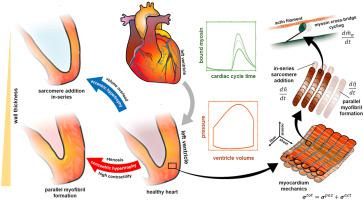Journal of the Mechanical Behavior of Biomedical Materials ( IF 3.3 ) Pub Date : 2020-09-12 , DOI: 10.1016/j.jmbbm.2020.104074 Eoin McEvoy 1 , William Wijns 2 , Patrick McGarry 1

|
Cardiac hypertrophy is an adaption of the heart to a change in cardiovascular loading conditions. The current understanding is that progression may be stress or strain driven, but the multi-scale nature of the cellular remodelling processes have yet to be uncovered. In this study, we develop a model of the contractile left ventricle, with the active cell tension described by a thermodynamically motivated cross-bridge cycling model. Simulation of the transient recruitment of myosin results in correct patterns of ventricular pressure predicted over a cardiac cycle. We investigate how changes in tissue loading and associated deviations in transient force generation can drive restructuring of cellular myofibrils in the heart wall. Our thermodynamic framework predicts in-series sarcomere addition (eccentric remodelling) in response to volume overload, and sarcomere addition in parallel (concentric remodelling) in response to valve and signalling disfunction. This framework provides a significant advance in the current understanding of the fundamental sub-sarcomere level biomechanisms underlying cardiac remodelling. Simulations reveal that pathological tissue loading conditions can significantly alter actin-myosin cross-bridge cycling over the course of the cardiac cycle. The resultant variation in sarcomere stress pushes an imbalance between the internal free energy of the myofibril and that of unbound contractile proteins, initiating remodelling. The link between cross-bridge thermodynamics and myofibril remodelling proposed in this study may significantly advance current understanding of cardiac disease onset.
中文翻译:

用于预测心室收缩性和重塑的热力学瞬态跨桥模型
心脏肥大是心脏适应心血管负荷条件的变化。目前的理解是,进展可能是压力或应变驱动的,但细胞重塑过程的多尺度性质尚未被发现。在这项研究中,我们开发了一个收缩性左心室模型,其活性细胞张力由热力学驱动的跨桥循环模型描述。模拟肌球蛋白的瞬时募集导致在一个心动周期内预测的心室压力的正确模式。我们研究了组织负荷的变化和瞬态力产生的相关偏差如何推动心壁细胞肌原纤维的重组。我们的热力学框架预测了响应体积过载的系列肌节增加(偏心重塑),和肌节平行添加(同心重塑)以响应瓣膜和信号功能障碍。该框架在当前对心脏重塑的基本亚肌节水平生物机制的理解方面取得了重大进展。模拟表明,病理组织负荷条件可以在心动周期过程中显着改变肌动蛋白-肌球蛋白跨桥循环。由此产生的肌节压力变化推动了肌原纤维的内部自由能与未结合的收缩蛋白之间的不平衡,从而引发了重塑。本研究中提出的跨桥热力学与肌原纤维重塑之间的联系可能会显着促进目前对心脏病发作的理解。










































 京公网安备 11010802027423号
京公网安备 11010802027423号